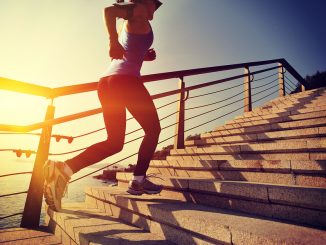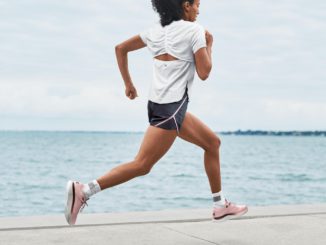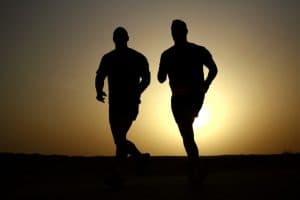
You don’t have to be a marathoner to benefit from a run. Running and jogging can be done anywhere. The only equipment that you need is a pair of running shoes. We’re not suggesting that you stop going to the gym, but we do think that running for fitness provides benefits that you can’t get from strength training alone.
What Are The Health Benefits Of Running For Fitness?
Jogging is good for your health in a number of ways. One of the most persuasive reasons to run for fitness is that the exercise can help you live longer [1]. In a study that was published in the Archives of Internal Medicine, researchers looked at disability and mortality among adults who were at least 50 years old. By the end of the 21-year study, 85 percent of the runners were still living, while only 66 percent of the non-runners survived.
A good run can produce a high that’s different than what you can achieve with other types of exercise. People have referred to this euphoria as a feeling of boundless energy, pleasure and inner harmony [2]. Many researchers have linked these sensations with feel-good chemicals that are released during vigorous or prolonged exercise. Runners describe themselves as having notably less depression, tension and fatigue than non-runners [3].
As you age, you tend to accumulate more fat around your midsection than other areas of your body. This is associated with medical conditions such as heart disease, high blood pressure and type II diabetes. In one study, people who ran at least 35 miles a week had a lower tendency to develop belly fat than people who ran fewer than nine miles during the same time frame [4].
Plus, diet alone might not keep the pounds off. Pounding the pavement is an effective way to burn calories. A 125-pound person burns about 300 calories in 30 minutes. That’s almost twice as many calories burned as low-impact aerobics [5].
[thrive_leads id=’5255′]
Many people avoid strapping on sneakers because they’re afraid of the impact that this type of exercise produces. Runners may not realize that they’re taking part in a weight-bearing exercise every time they take a stride. This type of movement can help strengthen the bones. If you’re just getting started, however, you need to know how to ramp up your exercise routine gradually so that you don’t develop stress fractures or other injuries.
Why Would You Want To Run For Fitness?
If you have a well-developed workout routine or belong to a gym, you might wonder why you should change up your exercise regimen. Going for a run is a wonderful alternative to hitting the gym. When you consider that a gym might be located at least 15 minutes from your home, you cut down on your commute time if you can simply open your front door and go for a jog.
You’ll need to spend some money on a supportive pair of sneakers, which protect your joints and can even improve your stride. The price of a pair of sneakers is equivalent to the cost of a one or two-month gym membership, though.
You can run alone or in groups. If you prefer to go solo, you can use the time to decompress. The activity can even be meditative. If you need accountability, you can join a group or sign up for a race for added motivation.
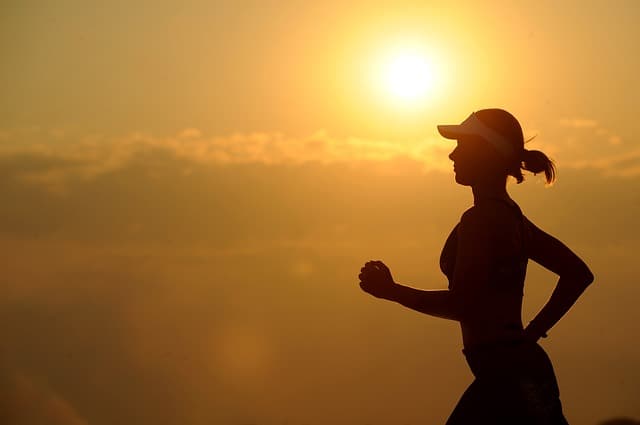
How To Start Running For Fitness
The best way to begin your journey with a new activity is to start slowly. Fit yourself with the perfect running shoes, decide where you want to run and head out the door.
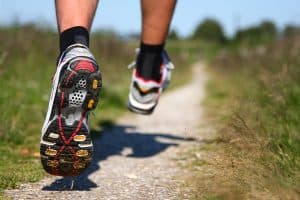
Many beginners look to the Couch to 5K app when they wonder how to start running for fitness. The app provides clear instructions for initiating a regimen. When you start, you’ll be guided through a timed run-walk process. As you continue, you run for longer periods of time and walk less. You’re supposed to be able to run 5 km, which equates to about 3.1 miles, within nine weeks.
Some people find that the Couch to 5K program is too difficult. We recommend starting even more gradually if you have never run before.
Begin by going for a walk. Bring your phone or a timer. When you feel ready, set the timer for two minutes, and start to jog. When the timer goes off, walk until you catch your breath. Then, run for another two minutes. Do this five times, and you will have run for 10 minutes total.

Every week, add to the run time. You may choose to increase your run time to 2 minutes and 30 seconds. At some point, you may even be able to put two of the run sessions together without a walking break in between.
Record your time every day that you run, and commit to going farther, faster or longer every week. Listen to your body, and only push harder if you can do so without injuring yourself.
To keep yourself interested, consider heading to different locations. You might try jogging on a grassy field, at the beach or on trails to reduce the impact on your joints. If you have access to a gym or a workout room, you can jog on a treadmill, where you can increase the incline to make things more challenging.
Problems You Might Run Into
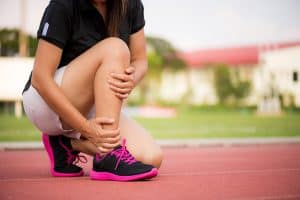
This type of exercise can be so motivating that you’re tempted to do it every day. If you haven’t run before, you might want to try doing it every other day to give your muscles time to recover.
If you’re experiencing any kind of pain, whether it’s in your shins or your joints, you may want to get evaluated by a physical therapist or the professionals at a shoe store that’s dedicated to runners. They will be able to help you determine whether you’re wearing the right sneakers for your gait. They may also be able to give you exercises to strengthen the muscles in your shins, calves and ankles.
You might wonder if you should run outdoors if you live in an area with polluted air. WebMD says that you take in more air when you’re doing aerobic activity than when you’re at rest [6]. It goes more deeply into your lungs, and if you breathe through your mouth, you don’t filter out as many particles. If you’re smart about where you run, the health benefits of exercise outweigh the risks from air pollution.
There are many websites that record the air pollution levels in your city. Timing your workouts to avoid heading outdoors when air quality is poorest will help you maximize your health and minimize exposure to toxic chemicals.
Sources
[1] https://www.ncbi.nlm.nih.gov/pubmed/18695077
[2] https://academic.oup.com/cercor/article/18/11/2523/291108
[3] http://journals.sagepub.com/doi/abs/10.2466/pms.1982.55.3f.1295
[4] https://journals.lww.com/acsm-msse/Fulltext/2011/11000/Exercise_Attenuates_the_Association_of_Body_Weight.13.aspx
[5] https://www.health.harvard.edu/diet-and-weight-loss/calories-burned-in-30-minutes-of-leisure-and-routine-activities
[6] https://www.webmd.com/fitness-exercise/features/ls-running-outside-toxic#1

Tim is the founder of FitAtMidlife.com – an avid gym rat for 30+ years, he’s a reviewer of many, many shoes – and founder of the Speed Bag Gathering – the world’s only gathering of speed bag punching enthusiasts. See more gym reviews at Tim’s YouTube channel.

